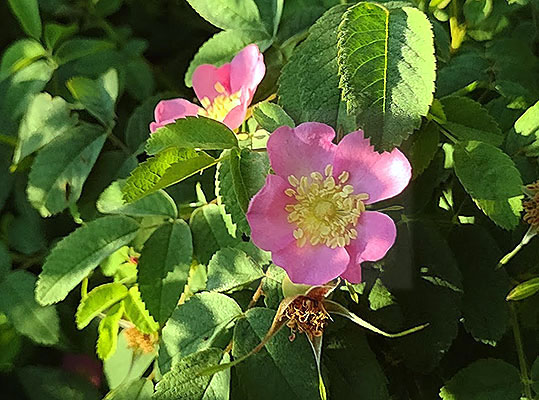Rosas by Any Other Thorn - ID guide by thorns or by clusters
- Ivy
- Nov 12, 2022
- 4 min read

The Rose family (Rosaceae) is full of stars. Actually, the flowers are like rounded stars themselves, with iconic 5-petals with rounded tips and many stamen in the middle like 3D soft-tipped stars. And so many are well known edibles. Strawberries, blackberries, apples, peaches, hawthorns, and service berries. Not to mention roses, which may be less known for their edibility. But you just may find “rose hips” on the ingredient list of a big brand tea package. Which makes someone like me wonder- do different roses taste differently? I mean, surely! They even have slightly different scents, well known to the perfume industry.

Pear flowers and apple flowers:


Many horticultural roses smell differently and quite a few don’t smell at all. The really showy ones tend to completely lack the classic ‘rose’ scent. What’s the Romeo & Juliet quote?
“A rose by any other name would smell as sweet”.
Shakespeare was well fond of the rose, saying at one point, “Of all flowers, methinks rose is best”. And writing “the rose looks fair, but fairer we it deem, for that sweet odour.”- Sonnet 54. That was when they all still had a strong linked scent and before 1867, when the first hybrid “tea rose” debuted and really started hybridizing and selectively breeding roses for their eye-candy and accidentally selected out the nose-sweetness. In case you are now wondering- Shakespeare wrote Romeo & Juliet around 1594ish.

Roses are actually one of the oldest flower families too, tracked in the fossil record to 35 million years ago, (oldest angiosperms, aka flowering plants, tracked to 135 million years ago) with about 150-200 species in the Rosa genus known today. The Greek goddess of love herself is said to be where “rose” comes from, as a rearrangement of her son’s name- Eros, the god of physical love & desire. The origin myth of the rose is beautiful, with most auxiliary gods and goddesses of Greek mythology taking part, reincarnating a dead forest nymph into the most beautiful flower of the rose.
Don’t get me wrong though- while the tales are nice and I appreciate the family, genus, and the many species, roses aren’t my favorite flower. Guess which is!
But as a botanist, I respect them. And in the PNW, we have several wild native roses that can be fairly hard to tell apart, plus some introduced species as well. Most of the hybrid highly-showy types don’t wander away from the tended gardens because they are also more needy- needing more water, fertilizer, pest control, etc. The Rosa genus spans all over Asia and North America, with one species known in Africa as well. The main evolution seemed to be from Asia, spreading to North America over the Bering Land Bridge and to Europe from Asia about 30 million years ago. Million! They didn't wait around to head to the "new world". Roses have been around and spread themselves to temperate habitat for a long time.

Rosaceae appears to have branched off from the Rubus genus (the bramble berries like raspberries, thimbleberries and salmon berries), which you can really see the resemblance to in their flowers and thorns.

The main species you may encounter in the wilds of the PNW include:
Rosa gymnocarpa, R. nutkana, R. multiflora, R. woodsii, and R. pisocapa for the native species. Shown in order below with dewy R. gymnocarpa first, R. multiflora 3rd in white and R. piscopa very pink & last. The common invasives are R. canina and R. rubiginosa.
R. pisocapa is mostly on the west side of the Cascade mountains with wide pear-shaped hips & twin thin thorns at base of flower stems, while R. woodsia is mostly on the east side and R. gymnocarpa is all over and one of the most commonly found. Luckily invasive R. rubiginosa is fairly sparse in WA but extends into many other states, even into the east coast, and is native to Eurasia. R. canina is also fairly uncommon in WA, with the giant cat-claw classic "rose" thorns and small flowers.
You can tell R. nutkana by it's paired larger thorns below leaves and smaller pricklers sparse on stem, also larger flowers, and R. gymnocapa, true to it's name, by having a naked fruit (no dried sepals still at the bottom) and are pear-shaped. And R. multiflora is also named for it's ID- many flowers on the stem, so a small cluster of rose hips will be around in fall and winter.


A rule of the bloodied thumb (to make this a little spooky fall themed): if the thorns curve clearly downward, the species is invasive. Native species all seem to have straight out and more bristle-looking thorns versus the vicious cat-claw thorns of ornamental rose species, escaped into the wild and becoming invasive.

Still a rule of thumb, since some native species’ thorns are curved, but still not nearly as wicked-looking as the weedy ones.

Every rose must have it's thorn, right?
Even the relatives like our scrumptious berries have their gentler ones. Strawberries however- delish rose-relative that's as friendly as a tame bunny, no kitty-claws in sight. Keep an eye out this winter for the tell-tale stabby stems of our wild roses and their kin. What's your favorite rose or delectable relative to encounter?
References:
Some pictures by Oregon State University and Flickr contributors: Laurel F., Matt Lavin, Andrey Zharkikh & Andreas Rockstein.
















Comments